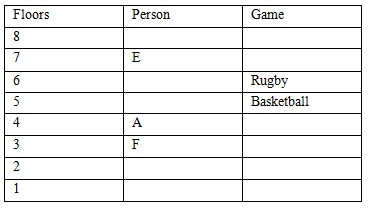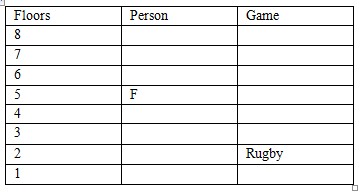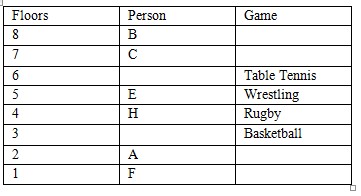Question
E likes which of the following
game? Study the following information carefully and answer the questions given below. Eight friends A, B, C, D, E, F, G and H live on eight different floors of a building but not necessarily in the same order. The lowermost floor of the building is numbered one and the topmost floor of the building is numbered eight. Each of them likes different games viz. Football, Rugby, Golf, Table Tennis, Basketball, Volleyball, Archery and Wrestling but not necessarily in the same order. (I) The one who likes Volleyball does not live on an odd- numbered floor. The one who likes Rugby lives on an even- numbered floor but not on the topmost floor. (II) Only one person lives between F and the one who likes Basketball. C does not like Basketball or Wrestling. (III) Neither E nor C lives on the first floor. A lives just above F. Only two persons live between E and A. (IV) The one who likes Basketball does not live on floor number one. B lives on an even- numbered floor and just above C. (V) The one who likes Table Tennis lives on an even numbered floor and lives just above the person who likes Wrestling. Only two persons live between F and the one who likes Rugby. C does not like Basketball or Wrestling. (VI) Only two persons live between the one who likes Volleyball and the one who likes Football. D does not like Archery. H lives just below the one who likes Wrestling. Only one person lives between C and the one who likes Golf.Solution
By I and V, Rugby can be on 2nd, 4th or 6th floor. So here we get 4 conditions. By II and IV we get the following arrangement. By III A lives just above F. Only two persons live between E and A. E does not live on 1st floor. I condition – By IV and II, I condition is not possible.  II condition – By II and IV Basketball can be either above or below F. So here we get two more conditions that is why we will hold this condition and move further with other conditions.
II condition – By II and IV Basketball can be either above or below F. So here we get two more conditions that is why we will hold this condition and move further with other conditions.  III condition – By II and IV, C does not like Basketball. B lives on an even- numbered floor and just above C. By V and VI, The one who likes Table Tennis lives on an even- numbered floor and lives just above the person who likes Wrestling and H lives just below the one who likes Wrestling. By I and VI, the one who likes Volleyball lives on an even- numbered floor. Only two persons live between the one who likes Volleyball and the one who likes Football. This condition is not possible.
III condition – By II and IV, C does not like Basketball. B lives on an even- numbered floor and just above C. By V and VI, The one who likes Table Tennis lives on an even- numbered floor and lives just above the person who likes Wrestling and H lives just below the one who likes Wrestling. By I and VI, the one who likes Volleyball lives on an even- numbered floor. Only two persons live between the one who likes Volleyball and the one who likes Football. This condition is not possible.  IV condition – By II and IV, C does not like Basketball. B lives on an even- numbered floor and just above C. By V and VI, The one who likes Table Tennis lives on an even- numbered floor and lives just above the person who likes Wrestling and H lives just below the one who likes Wrestling. By I and VI, the one who likes Volleyball lives on an even- numbered floor. Only two persons live between the one who likes Volleyball and the one who likes Football. By VI, Only one person lives between C and the one who likes Golf. D does not like Archery. So this condition is the final arrangement.
IV condition – By II and IV, C does not like Basketball. B lives on an even- numbered floor and just above C. By V and VI, The one who likes Table Tennis lives on an even- numbered floor and lives just above the person who likes Wrestling and H lives just below the one who likes Wrestling. By I and VI, the one who likes Volleyball lives on an even- numbered floor. Only two persons live between the one who likes Volleyball and the one who likes Football. By VI, Only one person lives between C and the one who likes Golf. D does not like Archery. So this condition is the final arrangement. 
What does IPV6 consist of in bits?
Which device uses much less computer time than the light pen and gives resolutions equal to that of the CRT display?
Which of the following statements, regarding the term ICT is/are TRUE ?
P : ICT is an acronym that stands for Indian Classical Technology.
Which of the following is also known as a flash drive?
Computer memory that temporarily stores information is called the ____.
Which layer of the OSI model is used for providing end-to-end error recovery and flow control?
When integrating an Excel file into a Word document, how is the data managed?
What is the difference between a CD-ROM and a CD-RW?
What is the primary function of a web browser?
Which among the following is incorrect about cache memory?
Relevant for Exams:


